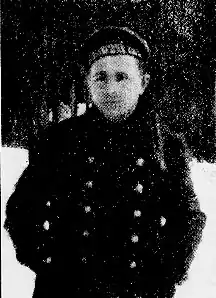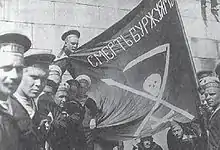Stepan Petrichenko
Stepan Maximovich Petrichenko (Russian: Степа́н Макси́мович Петриче́нко; 1892 – June 2, 1947) was a Russian revolutionary, an anarcho-syndicalist politician, the head of the Soviet Republic of Soldiers and Fortress-Builders of Nargen and in 1921, de facto leader of the Kronstadt Commune, and the leader of the revolutionary committee which led the Kronstadt rebellion of 1921.
Stepan Petrichenko | |
|---|---|
 | |
| Chairman of the Soviet Republic of Soldiers and Fortress-Builders of Naissaar | |
| In office December 1917 – February 26, 1918 | |
| Personal details | |
| Born | Stepan Maximovich Petrichenko 1892 Nikitenka, Kaluga Governorate, Russian Empire |
| Died | June 2, 1947 (aged 55) Vladimir Prison, Vladimir, Russian SFSR, Soviet Union |
| Nationality | Russian |
| Profession | Politician, revolutionary |
| Military service | |
| Allegiance | |
| Years of service | |
| Battles/wars | |

Life
Early years
Petrichenko was born in 1892 in the village of Nikitenka in Kaluga Governorate to a family of peasants. Two years after his birth, his family moved to Alexandrovsk (Yekaterinoslav Governorate), where Stepan graduated from city school and joined the local ironworks as a metalworker. In 1913 Petrichenko was called up for military service with the Russian navy, where he was assigned to the Russian battleship Petropavlovsk, part of the Baltic Fleet.[1]
Soviet republic of sailors and builders
During the February Revolution in Russia, he had been with the fleet at the Estonian island Nargen (now Naissaar). In December 1917, the Soviet Republic of Soldiers and Fortress-Builders of Nargen was proclaimed. Eighty-two sailors and about two hundred indigenous islanders organized local government, which lasted until the capture of Tallinn by the forces of the German Empire on February 26, 1918. The red and black flag of the anarcho-communists was lowered, and its "government" retreated onto the ships of the Baltic Fleet, heading for Helsinki, and from there to Kronstadt. Three years later, a red-black banner also hoisted over Kronstadt – the former leader of the Nargen "republic" Stepan Maksimovich Petrichenko led the Kronstadt uprising.[2]
In the "party week" of 1919, he joined the Russian Communist Party (Bolsheviks), but later resigned during the "re-registration" (veiled purge). Returning in the summer of 1920 from a visit to Aleksandrovsk (modern Zaporizhia), he praised Makhnovism, but he did not become an anarchist by conviction. He was not a career officer in the Baltic fleet, and when he took the responsibility of guiding the fleet he was an engineer on the battleship Petropavlovsk.
Kronstadt rebellion
In March 1921, with the outbreak of unrest in Kronstadt, he headed the governing body of the uprising – the Provisional Revolutionary Committee, but showed no political talents. The Kronstadters demanded the liquidation of the "autocracy of the communists."[3]
After the rebellion was exterminated by Trotsky, he fled over the ice to Finland, where he continued his agitation against the Bolsheviks.[4]
Emigrant
Petrichenko remained in exile in Finland for almost 25 years,[5] where his regard from fellow rebels remained high.[6]
He blocked further emigration to Helsinki, instead sending Kronstadt "volunteers" to Soviet Karelia to organize an uprising. He called on Kronstadters to not obey the order of General Wrangel, and refuse inclusion in the White Army. When an amnesty was declared for the ordinary participants in the uprising, by the decree of the All-Russian Central Executive Committee, Petrichenko didn't put obstacles in the way of those who wanted to return to their homeland and decided to ask for permission to return himself. Soon, the police chief of Vyborg received a denunciation of the "vile plot" of Petrichenko, as a result of which, on May 21, 1922, he was arrested and spent several months in prison.[1]
Agent
In 1922, Petrichenko went to Riga and visited the embassy of the RSFSR. There he was recruited by the State Political Directorate and became an agent of the Red Army Intelligence Agency in Finland.[7] In August 1927, Petrichenko again arrived in Riga and at the Soviet embassy filed an application addressed to Mikhail Kalinin with a request to return to Soviet citizenship.[1] In 1927, Petrichenko traveled through Latvia to the USSR. Returning to Finland, he got a job at a pulp mill in Kemi, where he worked until 1931. He was eventually fired from the factory and moved to live in Helsinki. In 1937, he announced his refusal to cooperate with Soviet intelligence, but then again agreed to continue working with them. He stayed in Finland for years, until he came into conflict with the Finnish government over his support of Soviet groups during the Winter War between the Soviet Union and Finland in 1940. In 1941, Petrichenko was arrested by the Finnish authorities.[8]
Arrest and death
On September 25, 1944, on the basis of an armistice agreement between the USSR, Great Britain and Finland, Petrichenko was released, and on April 21, 1945, he was again arrested and sent to the USSR, as part of a group of persons known as the "Prisoners of Leino".[9] The investigation into Petrichenko was transferred from the police to the NKVD where it was examined without the presence of the prosecution or the defense. The verdict passed on November 17, 1945, read:[1]
Petrichenko, Stepan Maximovich, for participation in a counter-revolutionary terrorist organization and belonging to Finnish intelligence, is to be imprisoned in a forced labor camp for a period of 10 years, counting the period from April 24, 1945.
Stepan Petrichenko died on June 2, 1947, while being transported from the Solikamsk camp to Vladimir Prison.
Work
- Petrichenko, Stepan (1921). Pravda o kronshtadtskikh sobytiiakh. (Russian: Правда о кронштадтских событиях) (bibrec); English: The truth about the Kronstadt events
References
- Prokhorov D. "The tragedy of the Kronstadt "rebel"" (in Russian). Archived from the original on June 4, 2012. Retrieved November 29, 2008.
- Naissaar. Republic of Soviets
- Семанов С. Н. Черные дни Кронштадта
- Events in Kronstadt
- Avrich 1970, p. 217.
- Avrich 1970, p. 216.
- M. Hosta, O. Lapchinsky, S. Kosher SPY DEATH
- The beginning of 1940 (in Finnish).
- Björkelund B.V. Travel to the land of all kinds of impossibilities / Prep. text for publication, scientific. ed., entry Art. and comm. S. A. Mankova. – SPb .: International Association of "Russian Culture", 2014.
External links
Bibliography
- Avrich, Paul (1970). Kronstadt, 1921. Princeton, N.J.: Princeton University Press. ISBN 0-691-08721-0. OCLC 67322.
